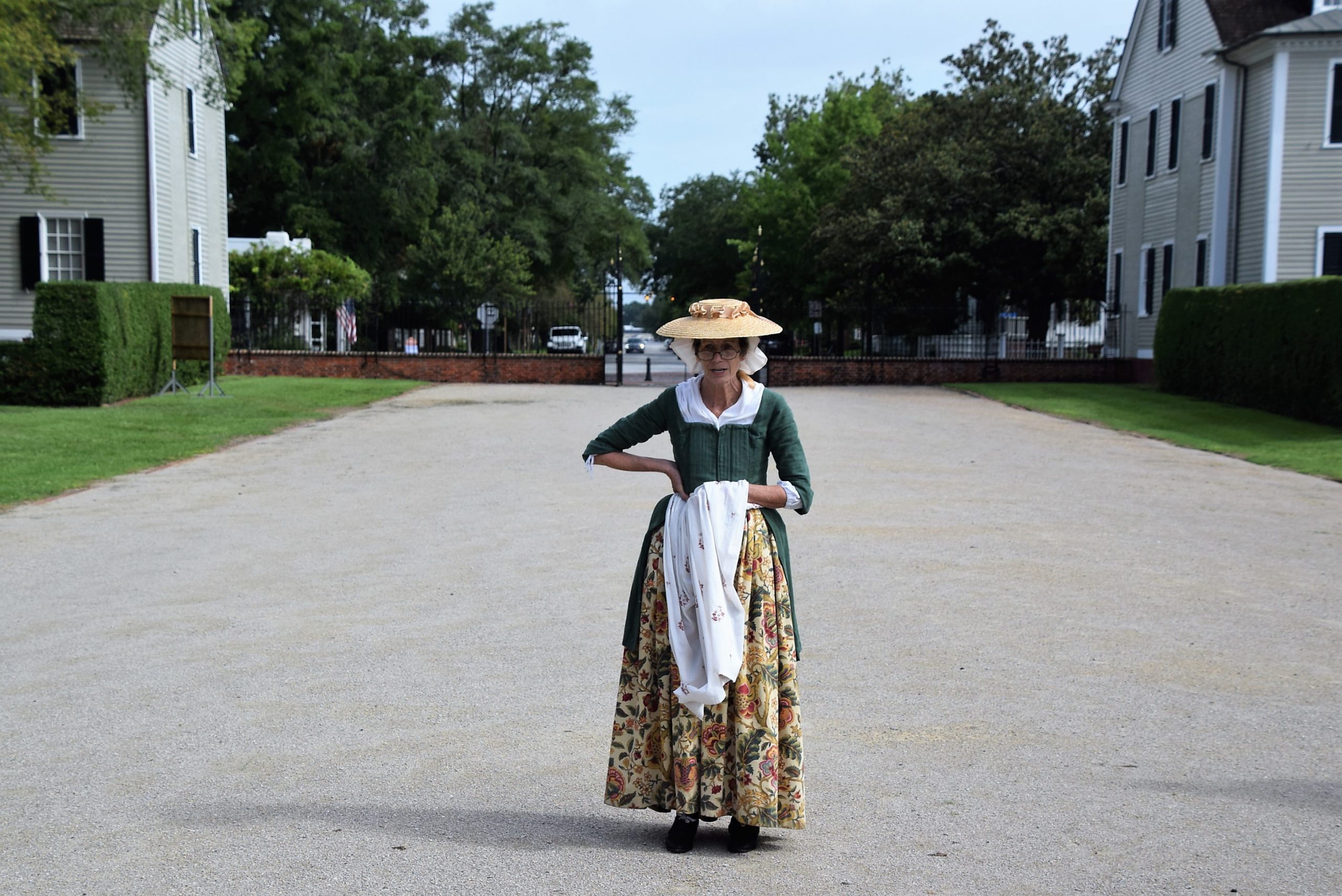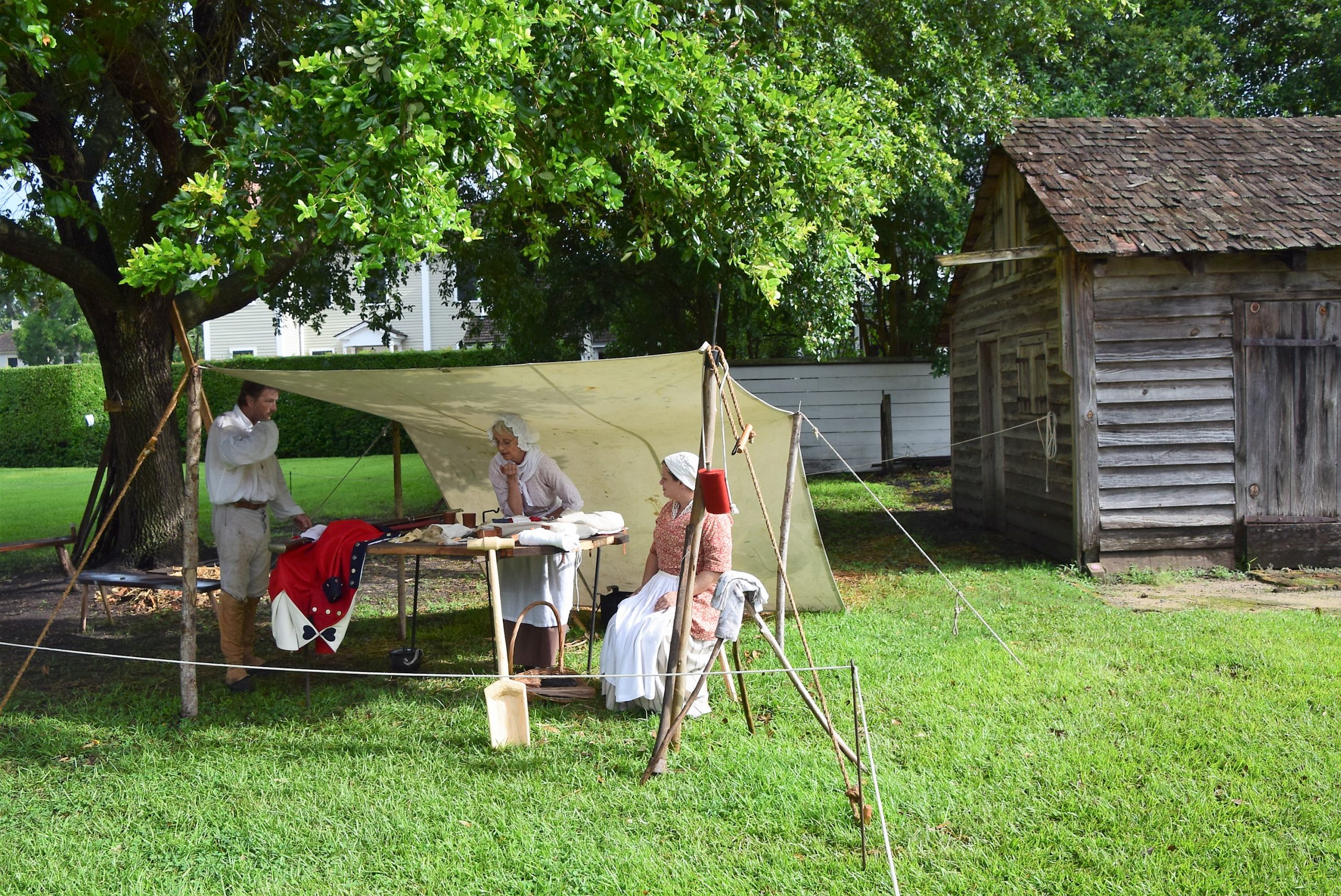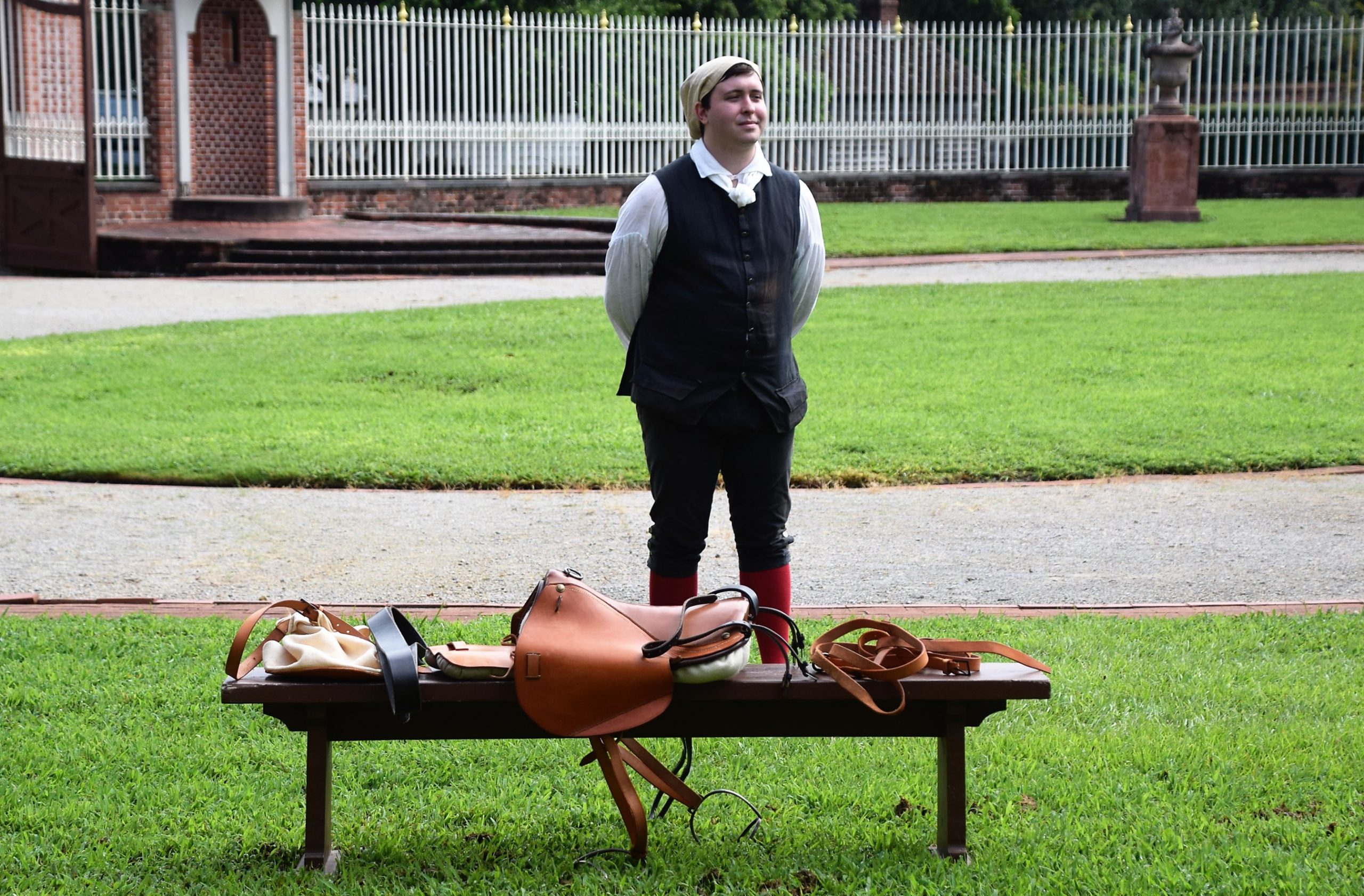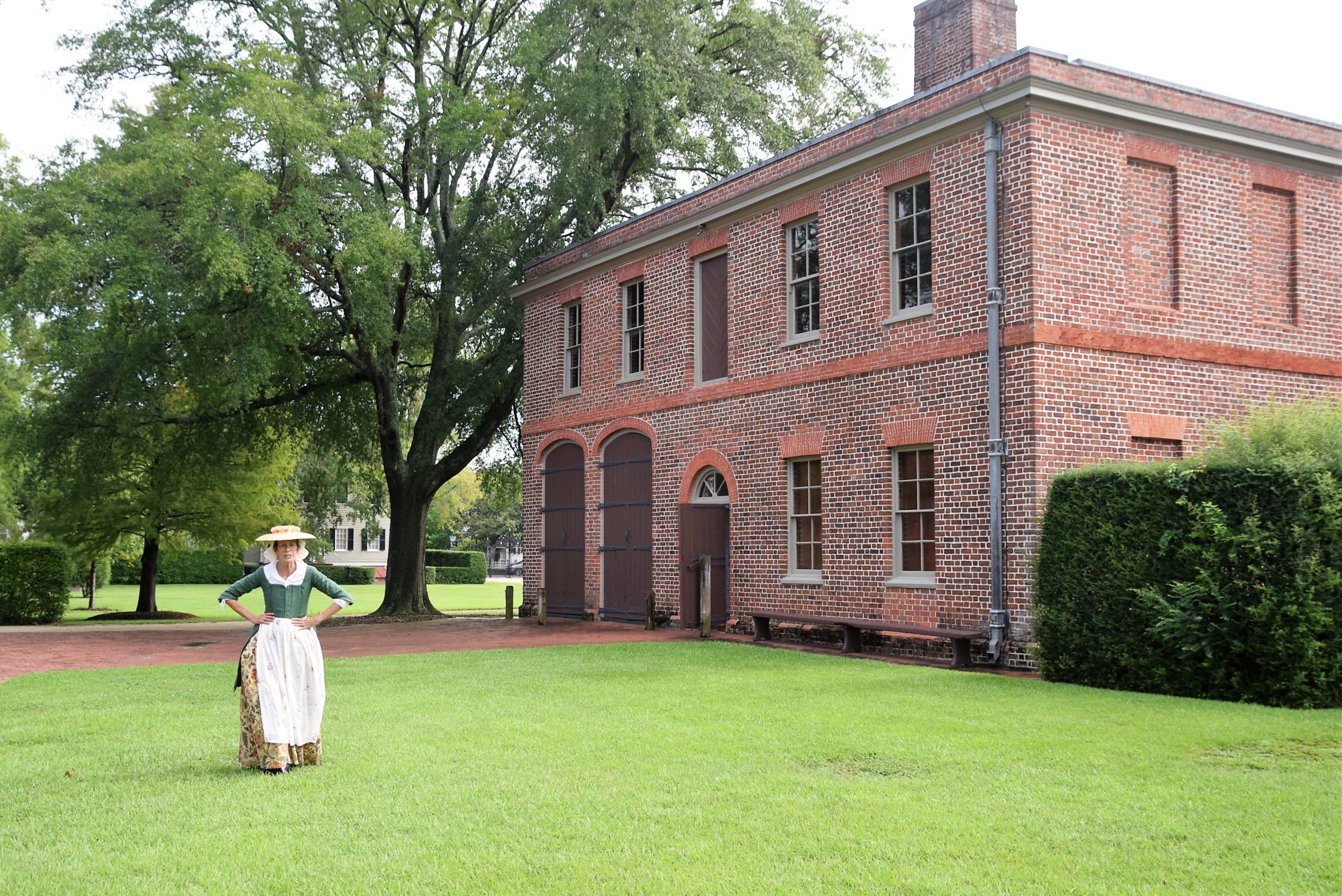
NEW BERN — Tryon Palace helped visitors Saturday morning get a glimpse of everyday life on a hot, muggy August day in 1771, shortly after the Battle of Alamance and the small window of time between Gov. William Tryon leaving to be governor in New York and Josiah Martin arriving to serve as governor.
Like the lead characters of the “Outlander” series, Claire and Jamie Fraser, the two groups of 10, all wearing masks, saw what the palace in New Bern was like as unrest brewed before the American Revolution.
Supporter Spotlight
Dressed in period clothing, historic interpreter Susan Griffin explained to the group outside Tryon Palace that while fans of “Outlander” would have read about Tryon from the Frasers perspective, they would during the sold-out event, Discovering Tryon Palace: The Spark of Rebellion, hear from Tryon’s side. Saturday was the first time this event was offered.
“We’ll give you a taste of what it was like to be here,” Griffin said, “Tryon has left, the Battle (of Alamance) is a couple of months behind us, and we’re waiting for a new governor.”
The eight-book “Outlander” series, on which the Starz series is based, is historical romance fiction created by author Diana Gabaldon. The series follows the life of a British World War II nurse, Claire Randall, who accidentally travels through a stone portal in the Scottish Highlands from 1946 to 1743, where she meets and falls in love with Jamie Fraser, a Highland Scot.
The first three novels weave through the 18th and 20th centuries, eventually taking the couple to North Carolina in the fourth novel, “Drums of Autumn,” and subsequent books. In addition to the North Carolina mountains, Tryon Palace in New Bern and Alamance Battleground in Burlington, site of the battle between the Regulators and Tryon’s troops, are featured.
Several characters and events in the book are fictionalized accounts of real people and events, such as Tryon, who served as Colonial North Carolina’s eighth governor from 1765-1771, and is prominent in “Drums of Autumn” and “The Fiery Cross,” the fifth book.
Supporter Spotlight
Many North Carolinians in the 1760s and 1770s were angry about the tax levied to build a capitol and governor’s residence in New Bern, which they called “Tryon’s Palace,” dishonest officials and lack of representation for the western part of the state, so they formed the Regulators, according to the state Natural and Cultural Resources. Tryon led militia into the backcountry in 1768 and 1771, defeating the Regulators at the May 16, 1771, Battle of Alamance. Tryon soon left for New York to serve as governor there.
The state Department of Natural and Cultural Resources sites featured in the series have seen a boost in tourism and offer “Outlander” themed tours.
“We have definitely seen something of an ‘Outlander’ effect on visitation at N.C. State Historic Sites associated with the ‘Outlander’ books and television series – especially since the TV series characters crossed the Atlantic in season four to take up residence in North Carolina,” Michele Walker, public information officer for the state Department of Natural and Cultural Resources, told Coastal Review Online.
“Visitors to Tryon Palace, Alamance Battleground and other sites associated with the story are excited to take special ‘Outlander’ tours and learn more about the real history behind the books. The series’ author, Diana Gabaldon, even joined us at a number of N.C. locations last year for fundraising events.”
“Outlander” themed tours at Tryon Palace continue to be one of the sites most popular offerings, regularly selling out. Special outdoor-only tours are currently scheduled monthly, she added.
Having been closed since March, the gardens at Tryon Palace starting Monday are now open seven days a week to ticketed visitors. The state is still following Gov. Roy Cooper’s Phase 2 orders, so the palace, North Carolina History Center and historical homes remain closed. Tickets to view the gardens are available at the Waystation ticket office, 610 Pollock St. Visitors can also expect onsite historic interpreters with live demonstrations of Colonial living. Visit the website for new programs and updates.
Zaneta Padilla, marketing manager for Tryon Palace, told Coastal Review Online that the shutdowns related to the COVID-19 pandemic have severely limited the events the site usually offers, “but we’ve approached the situation creatively by adjusting our procedures. We try to do as much as we can outside. By segregating groups into smaller numbers, we can offer our visitors a richer experience with more face-to-face time with our interpreters, allowing more engagement.”

At the event Saturday, a few gossipy wives and a militia member – portrayed by interpreters — from the militia encampment had set up camp under a tree near the front of the palace. The interpreters walked the crowd through the everyday items on display, including what a militia man would carry in his sack.
There was also a replica of a redcoat that would have been worn by the British Army, which Sarah said Jamie Fraser didn’t seem pleased with the idea of wearing.
“The Colony of North Carolina had the largest population of pardoned Jacobite colonists in all of the Colonies, something about the mountains seemed to call home,” she said. “Col. Fraser, being a pardoned Jacobite, didn’t seem to enjoy putting that coat on very much although he did very much enjoy taking it off.”
Early in the “Outlander” series, Jamie Fraser is part of the Jacobite movement and fights in the 1746 Battle of Culloden in the Scottish Highlands, which the British won. Jacobites wanted to restore the Catholic king, James VII of Scotland and II of England, in favor of his Protestant daughter and son-in-law, Mary II and William of Orange, according to University of Dundee.
“During the late 17th and 18th centuries, the Jacobites were responsible for innumerable plots and conspiracies against William and Mary and their successors. They also fought a devastating civil war in Ireland during the 1690s, and mounted four armed insurrections in Britain – mainly Scotland – in 1689-91, 1715, 1719 and 1745-46. The movement effectively came to an end with the Jacobites’ defeat at the battle of Culloden in April 1746,” according to the university.
The group made their way from the encampment through the kitchen gardens on the muggy Saturday morning to seek medical advice from the apothecary. He told the crowd he found the methods of Claire Fraser questionable, who applied her 20th century medical training to healing in the 18th century.
The apothecary said he understood that Claire Fraser had a rather large collection of moldy bread in her house, and while there are some medical uses for moldy bread, she was injecting “a sign of decay” into the body, which is something he would try to avoid.

After learning about medicine during the 1770s, Griffin led the group through the stables to hear about Tryon and his horses from the palace’s groom.
The groom showed the parts of saddle that Tryon likely would have used. He mentioned that Tryon was an excellent horseman and insisted that the stables be filled with horses while he served as governor. The stables were currently empty while waiting for the new governor.
He said Tryon was a “harsh but fair man” but left a bit of a mess for Gov. Martin to clean up but did credit Tryon for improving the road system between Virginia and South Carolina.

In a follow-up interview, Griffin said she was glad to learn the guests enjoyed the newest addition to Discovering Tryon Palace series, Outlander: The Spark of Rebellion.
“Happier still, to report we outlandish ‘servants’ of the palace are thrilled to be back sharing North Carolina’s rebellious history,” she said.
Griffin explained that Gabaldon’s “Outlander” series, while fiction, offers many real, factual moments of our state’s history.
“She has helped to remind us of the Southern voice and perspective of our American Revolutionary history. Today, as we approach the 250th anniversary of the Battle of Regulation in Alamance, North Carolin,a next spring — and our nation’s 250th anniversary in 2026 — the ‘Outlander’ series also reminds us that we share many of the same issues of the generation, which began the pursuit of ‘liberty and justice for all’ in 1776,” Griffin said. “Traveling through time since then, each successive generation of our diverse and resilient American family has spiritedly continued the conversation just as we, now in the 21st century, determine our definition of those revolutionary words and how we will carry the light of liberty onward.”
An admitted bookworm, Griffin said she very much enjoys literary-based tours and is a fan of the “Outlander” series.
“Whether fact or fiction, I am ready to travel in literary footsteps both real and imagined. Spoiler alert: We docents of Tryon Palace get to walk in the historical figures as well as the fictional Frasers and their friends every day,” she said. “As a teacher of civics and history, I want to know that facts as they relate to the fiction, ever a student, always seeking to learn more.”
Her favorite aspect of the “Outlander” tours is that they seem to be like attending an extended family reunion. “We may not recognize one another on sight, but we fall into instant kinship when we begin to compare notes of the familiar events of the characters we know well.”
She encourages visitors to make their way to Tryon Palace to hear more real voices from the past through the present to learn the history of North Carolina, and beyond.

In addition to Tryon Palace and Alamance Battleground State Historic Site, NCDNR compiled this list of North Carolina’s Outlander Connections in the series or connected to Colonial life, frontier life and Native American culture:
- Brunswick Town/Fort Anderson, Winnabow, mentioned in “A Breath of Snow and Ashes.”
- Historic Bath, The books feature fictional pirate Stephen Bonnet. Actual pirate Stede Bonnet had ties to Bath.
- Historic Edenton, mentioned in “Drums of Autumn” and “The Fiery Cross.”
- Historic Halifax, in “Drums of Autumn” and “The Fiery Cross.”
- Grandfather Mountain State Park, Linville, is the estimated location of the fictional Fraser’s Ridge, where Jamie and Claire settled, in the western part of North Carolina.
- Cape Fear Historical Complex, Fayetteville. This location was the historic epicenter of Scottish migration during the Colonial era. Fayetteville was once known as Cross Creek, in “Drums of Autumn” and “The Fiery Cross.”








